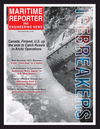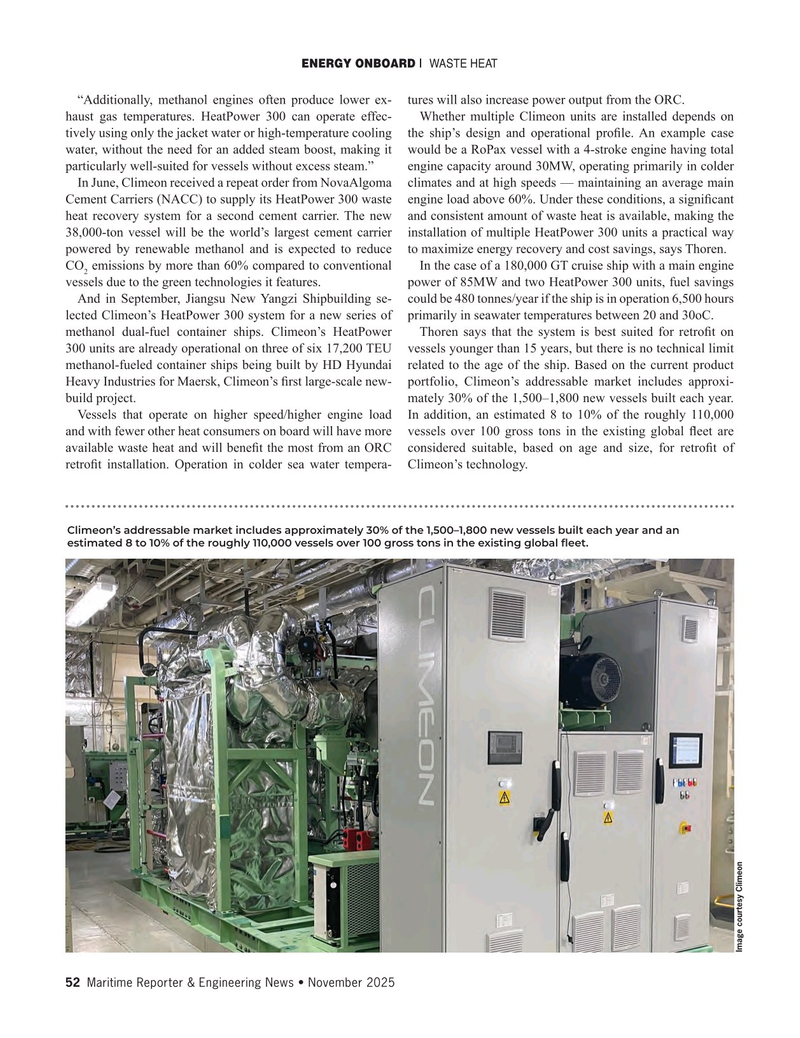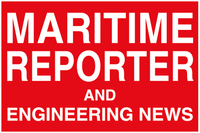
Page 52: of Maritime Reporter Magazine (November 2025)
Read this page in Pdf, Flash or Html5 edition of November 2025 Maritime Reporter Magazine
ENERGY ONBOARD | WASTE HEAT “Additionally, methanol engines often produce lower ex- tures will also increase power output from the ORC. haust gas temperatures. HeatPower 300 can operate effec- Whether multiple Climeon units are installed depends on tively using only the jacket water or high-temperature cooling the ship’s design and operational pro? le. An example case water, without the need for an added steam boost, making it would be a RoPax vessel with a 4-stroke engine having total particularly well-suited for vessels without excess steam.” engine capacity around 30MW, operating primarily in colder
In June, Climeon received a repeat order from NovaAlgoma climates and at high speeds — maintaining an average main
Cement Carriers (NACC) to supply its HeatPower 300 waste engine load above 60%. Under these conditions, a signi? cant heat recovery system for a second cement carrier. The new and consistent amount of waste heat is available, making the 38,000-ton vessel will be the world’s largest cement carrier installation of multiple HeatPower 300 units a practical way powered by renewable methanol and is expected to reduce to maximize energy recovery and cost savings, says Thoren.
CO emissions by more than 60% compared to conventional In the case of a 180,000 GT cruise ship with a main engine 2 vessels due to the green technologies it features. power of 85MW and two HeatPower 300 units, fuel savings
And in September, Jiangsu New Yangzi Shipbuilding se- could be 480 tonnes/year if the ship is in operation 6,500 hours lected Climeon’s HeatPower 300 system for a new series of primarily in seawater temperatures between 20 and 30oC.
methanol dual-fuel container ships. Climeon’s HeatPower Thoren says that the system is best suited for retro? t on 300 units are already operational on three of six 17,200 TEU vessels younger than 15 years, but there is no technical limit methanol-fueled container ships being built by HD Hyundai related to the age of the ship. Based on the current product
Heavy Industries for Maersk, Climeon’s ? rst large-scale new- portfolio, Climeon’s addressable market includes approxi- build project. mately 30% of the 1,500–1,800 new vessels built each year.
Vessels that operate on higher speed/higher engine load In addition, an estimated 8 to 10% of the roughly 110,000 and with fewer other heat consumers on board will have more vessels over 100 gross tons in the existing global ? eet are available waste heat and will bene? t the most from an ORC considered suitable, based on age and size, for retro? t of retro? t installation. Operation in colder sea water tempera- Climeon’s technology.
Climeon’s addressable market includes approximately 30% of the 1,500–1,800 new vessels built each year and an estimated 8 to 10% of the roughly 110,000 vessels over 100 gross tons in the existing global

 51
51

 53
53
